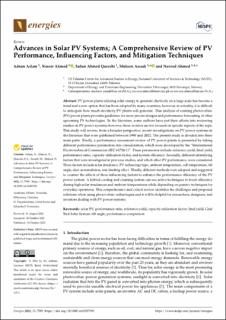| dc.contributor.author | Aslam, Adnan | |
| dc.contributor.author | Ahmed, Naseer | |
| dc.contributor.author | Qureshi, Safian Ahmed | |
| dc.contributor.author | Assadi, Mohsen | |
| dc.contributor.author | Ahmed, Naveed | |
| dc.date.accessioned | 2023-04-13T07:55:27Z | |
| dc.date.available | 2023-04-13T07:55:27Z | |
| dc.date.created | 2022-11-12T09:17:57Z | |
| dc.date.issued | 2022 | |
| dc.identifier.citation | Aslam, A., Ahmed, N., Qureshi, S. A., Assadi, M., & Ahmed, N. (2022). Advances in solar PV systems; A comprehensive review of PV performance, influencing factors, and mitigation techniques. Energies, 15(20), 7595. | en_US |
| dc.identifier.issn | 1996-1073 | |
| dc.identifier.uri | https://hdl.handle.net/11250/3062780 | |
| dc.description.abstract | PV power plants utilizing solar energy to generate electricity on a large scale has become a trend and a new option that has been adopted by many countries; however, in actuality, it is difficult to anticipate how much electricity PV plants will generate. This analysis of existing photovoltaic (PV) power plants provides guidelines for more precise designs and performance forecasting of other upcoming PV technologies. In the literature, some authors have put their efforts into reviewing studies on PV power systems; however, those reviews are too focused on specific aspects of the topic. This study will review, from a broader perspective, recent investigations on PV power systems in the literature that were published between 1990 and 2022. The present study is divided into three main parts. Firstly, a performance assessment review of PV power plants is presented by taking different performance parameters into consideration, which were developed by the “International Electrotechnical Commission (IEC 61724-1)”. These parameters include reference yield, final yield, performance ratio, capacity utilization factor, and system efficiency. Secondly, different identifying factors that were investigated in previous studies, and which affect PV performance, were considered. These factors include solar irradiance, PV technology type, ambient temperature, cell temperature, tilt angle, dust accumulation, and shading effect. Thirdly, different methods were adopted and suggested to counter the effects of these influencing factors to enhance the performance efficiency of the PV power system. A hybrid cooling and cleaning system can use active techniques to boost efficiency during high solar irradiances and ambient temperatures while depending on passive techniques for everyday operations. This comprehensive and critical review identifies the challenges and proposed solutions when using photovoltaic technologies and it will be helpful for researchers, designers, and investors dealing with PV power systems. | en_US |
| dc.language.iso | eng | en_US |
| dc.publisher | MDPI | en_US |
| dc.rights | Navngivelse 4.0 Internasjonal | * |
| dc.rights.uri | http://creativecommons.org/licenses/by/4.0/deed.no | * |
| dc.title | Advances in Solar PV Systems; A Comprehensive Review of PV Performance, Influencing Factors, and Mitigation Techniques | en_US |
| dc.type | Peer reviewed | en_US |
| dc.type | Journal article | en_US |
| dc.description.version | publishedVersion | en_US |
| dc.rights.holder | The authors | en_US |
| dc.subject.nsi | VDP::Teknologi: 500 | en_US |
| dc.source.volume | 15 | en_US |
| dc.source.journal | Energies | en_US |
| dc.source.issue | 20 | en_US |
| dc.identifier.doi | 10.3390/en15207595 | |
| dc.identifier.cristin | 2072782 | |
| cristin.ispublished | true | |
| cristin.fulltext | original | |
| cristin.qualitycode | 1 | |

